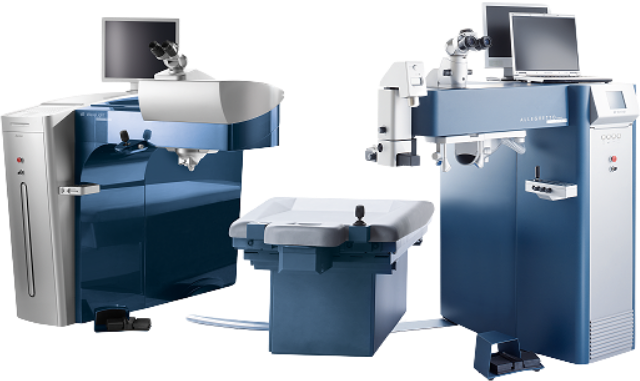LASIK

Do you want to enjoy sharp, clear vision without needing glasses or contacts? Achieve the high-definition eyesight of your dreams with LASIK, a minimally invasive procedure that has improved the vision of millions.
At SightTrust Eye Institute, our experienced LASIK surgeon and Board Certified Ophthalmologist, Dr. Cory Lessner, has performed thousands of successful refractive procedures and is passionate about helping his patients see the world in vibrant clarity.
What is LASIK?
LASIK stands for laser-assisted in situ keratomileusis, a minimally invasive procedure that involves reshaping the cornea to correct refractive errors like nearsightedness, farsightedness, and astigmatism. These refractive errors cause light to hit the retina at the wrong spot, leading to unfocused vision.
By reshaping the cornea using specialized lasers, LASIK directs light to the center of the retina for crisp, clear images. Most LASIK patients no longer need to use glasses or contacts, and enjoy crystal-clear vision for decades!
What are the Benefits of LASIK?
Once you’ve undergone LASIK, you can look forward to the many benefits of clear vision, including:
Simpler Daily Routines
Scrambling for your glasses on your bedside table every morning or performing a complex contact lens cleaning routine every night can be frustrating and take valuable time out of your day. After LASIK, you’ll wake up and fall asleep each night with clarity and be able to jump right into your day without your vision holding you back.
Visual Freedom

Glasses and contacts aren’t just a momentary hassle; they can also make it difficult to be spontaneous and enjoy activities without worrying about clear vision. After LASIK, you’ll no longer have to opt out of activities like swimming at the beach because you’re wearing contacts, or enjoying a last-minute ski trip because you’re not equipped with the proper prescription goggles.
Instead, you’ll have the comfort of knowing that you can see clearly 24/7. You also won’t have to factor visual aids into trips either.
Rather than stressing over whether you brought enough daily lenses or sacrificing room in your carry-on for backup glasses, you can enjoy the sights of your travels in stunning clarity and live in the moment.
Improved Visual Acuity
LASIK improves many aspects of your vision, including visual acuity and depth perception. This is especially beneficial if you play sports, as seconds and inches can matter when trying to score a point for your team.
With sharper eyesight, you can have better reaction times, a clearer view of other players around you, and more accuracy when making a basket or goal. Improved visual acuity can also benefit patients who participate in hobbies requiring attention to detail, like crocheting, painting, or playing an instrument.
Investment in Your Vision
While LASIK has an upfront cost, it can actually save you money in the long run. Most patients who wear glasses and contacts spend around $500 a year on them, which adds up over time, especially if you need repairs, prescription changes, or lose your visual aids.
LASIK eliminates this cost, eventually paying for itself over multiple years of not needing visual aids.
Who is a Good Candidate for LASIK?

While millions of patients have achieved better eyesight with LASIK, the procedure is not right for everyone. You’ll need to meet certain qualifications to undergo the procedure, including:
- Being 18 years or older
- Having a refractive error within the range that LASIK can correct
- Having stable vision for at least one year
- Not being pregnant or nursing
- Not having autoimmune conditions that could interfere with the LASIK healing process, like lupus, rheumatoid arthritis, or Sjogren’s syndrome
- Not having eye conditions like cataracts, glaucoma, or severe dry eye
- Having thick enough corneas for the procedure
- Having realistic expectations about the visual outcomes of LASIK
Your eye doctor at SightTrust Eye Institute will conduct a thorough consultation to determine if you are a good candidate for LASIK. At this appointment, they will perform an eye exam, answer your questions about the procedure, review your medical history, and discuss your lifestyle and vision goals.
What if I’m Not a Good Candidate for LASIK?
If you are not a good candidate for LASIK, your eye doctor may recommend one of the alternative vision correction procedures we offer at SightTrust Eye Institute, like SMILE or PRK. These procedures are often great choices for patients who cannot undergo LASIK due to thin corneas or severe dry eye:
SMILE

SMILE is a laser vision correction procedure that can treat nearsightedness and astigmatism. Instead of creating a flap like LASIK, the SMILE procedure involves using a femtosecond laser to make a small disc of tissue on your eye called a lenticule.
Your eye surgeon will then use the laser to make a tiny incision in your eye, pulling the lenticule through the incision. This corrects your refractive errors and offers the same visual benefits as LASIK, including clearer eyesight and reduced reliance on visual aids.
PRK
As the first vision correction procedure, PRK has been used to correct nearsightedness, farsightedness, and astigmatism for decades. Like SMILE, there is no corneal flap created during PRK.
Instead, the entire epithelium is removed, and the corneal tissue underneath is reshaped using an excimer laser. While this procedure has the same visual benefits as LASIK and SMILE, it takes longer to recover as the epithelium needs time to regenerate.
Refractive Lens Exchange
Refractive lens exchange (RLE) is a vision correction procedure that can correct the same refractive errors as LASIK, as well as presbyopia. The best candidates for RLE are over 40 years old, have presbyopia and/or other refractive errors, or have early cataracts.
It’s also a good LASIK alternative for patients with thin corneas, dry eye, or severe refractive errors beyond the range that LASIK can correct.
The RLE procedure removes the natural lens of the eye and replacing it with an IOL or intraocular lens. This procedure also helps patients avoid cataracts down the line because of the lens replacement aspect. You can choose between various IOLs that each offer different benefits to suit your specific lifestyle and vision goals.
What Happens During LASIK?
Before beginning LASIK, your surgeon will numb your eyes with anesthetic eye drops to ensure you are comfortable. Then, they will use a femtosecond laser to make a small, hinged flap in the surface layer of the cornea.
Your LASIK surgeon will fold back the flap to access the tissue underneath and reshape it using an excimer laser. Once your refractive errors have been corrected, they will place the flap back over the eye.
The entire procedure typically takes less than 30 minutes and requires no stitches or sutures. Your LASIK surgeon will briefly monitor you after the procedure and give you instructions for postoperative care.
What is LASIK Recovery Like?
After LASIK, you will need a friend or loved one to drive you home. Most patients are cleared to resume driving at their follow-up appointment the next day, depending on how they are healing.
While at home, be sure to follow your LASIK surgeon’s directions, including:
- Applying prescription eye drops
- Wearing your eye shield when you sleep
- Refraining from rubbing your eyes
- Not wearing eye makeup
- Avoiding getting water in your eyes
- Wearing UV-protective sunglasses when outside
- Refraining from sports and strenuous activity
Although recovery times can vary between patients, most can return to their normal routine within one to three days. Your eye doctor will provide you with more specific instructions on when you can resume regular activities at your follow-up appointments.
What Will My Vision Be Like After LASIK?

Most patients report immediate visual improvements after LASIK, enjoying crisper, clearer vision right away. Others notice their vision improves more gradually as they heal over the next few days.
Your vision will continue to sharpen as time goes on, reaching peak clarity several months after the procedure. Most patients enjoy high-definition eyesight 24/7 and no longer need glasses or contacts.
While LASIK cannot prevent vision changes from unrelated conditions like presbyopia, cataracts, or age-related macular degeneration, it permanently corrects your refractive errors and can give you crystal-clear vision for decades.
Are you interested in improving your eyesight with LASIK? Schedule an appointment at SightTrust Eye Institute in Sunrise, FL, today!


